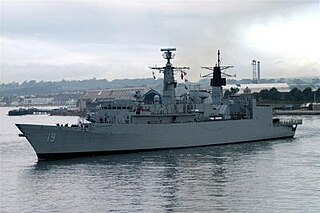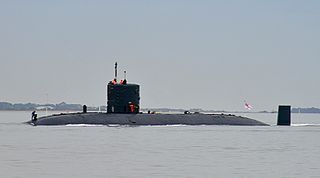
The Swiftsure class was a class of nuclear-powered fleet submarines in service with the Royal Navy from the early 1970s until 2010.

The Trafalgar class is a class of nuclear-powered fleet submarines (SSNs) in service with the Royal Navy, and the successor to the Swiftsure class. Like the majority of Royal Navy nuclear submarines, all seven boats were constructed at Barrow-in-Furness shipyard, Cumbria. With only one boat remaining active and in commission and six retired from the seven originally in service, the class makes up part of the Royal Navy's nuclear-powered ‘hunter-killer’ submarine force. The Trafalgar class is being gradually replaced by the larger and more capable Astute class, of which five are currently commissioned.

HMS Astute is an operational nuclear-powered attack submarine in the Royal Navy, the lead boat of her class.

HMS Splendid was a Royal Navy nuclear-powered fleet submarine of the Swiftsure class. From commissioning in 1979 to her decommission in 2004 she took part in many operations involving British forces around the globe.

HMS Triumph is a Trafalgar-class nuclear submarine of the Royal Navy and was the seventh and final boat of her class. She is the nineteenth nuclear-powered hunter-killer submarine built for the Royal Navy. Triumph is the tenth vessel, and the second submarine to bear the name. The first HMS Triumph was a 68-gun galleon built in 1561.

HMS Sheffield is a Type 22 frigate originally in service with the British Royal Navy. Initially it was meant to be called Bruiser but was named Sheffield in honour of the previous Sheffield, a Type 42 destroyer sunk in the Falklands War. Entering service in 1988, Sheffield served with the Royal Navy until 2002. In 2003, the vessel was acquired by the Chilean Navy and renamed Almirante Williams. The frigate is currently in service with the Chilean Navy.

HMS Trafalgar is a decommissioned Trafalgar-class submarine of the Royal Navy. Unlike the rest of the Trafalgar-class boats that followed, she was not launched with a pump-jet propulsion system, but with a conventional 7-bladed propeller. Trafalgar was the fifth vessel of the Royal Navy to bear the name, after the 1805 Battle of Trafalgar.

HMS Tireless was the third Trafalgar-class nuclear submarine of the Royal Navy. Tireless is the second submarine of the Royal Navy to bear this name. Launched in March 1984, Tireless was sponsored by Sue Squires, wife of Admiral 'Tubby' Squires, and commissioned in October 1985.

HMS Torbay is a decommissioned Trafalgar-class nuclear submarine of the Royal Navy and the fourth vessel of her class. Torbay was the fifth vessel and the second submarine of the Royal Navy to be named after Torbay in Devon, England. The first vessel was the 80-gun second rate HMS Torbay launched in 1693.

HMS Trenchant was a Trafalgar-class nuclear-powered fleet submarine of the Royal Navy built by Vickers Shipbuilding, Barrow-in-Furness. Trenchant was based at HMNB Devonport. She was the third vessel and the second submarine of the Royal Navy to be named for the characteristic of vigour and incisiveness.

HMS Talent was the sixth of seven Trafalgar-class nuclear submarines of the Royal Navy, and was built at Barrow-in-Furness. Talent was launched by The Princess Royal in April 1988 and commissioned in May 1990. The boat is affiliated with Shrewsbury in Shropshire. Talent is the third submarine of the Royal Navy to bear the name. The first was the World War II Talent, a T-class submarine transferred to the Royal Netherlands Navy as HNLMS Zwaardvisch in 1943.

HMS Ambush is an Astute-class nuclear-powered attack submarine of the Royal Navy, the second boat of her class.
HMS Artful is the third Astute-class nuclear-powered fleet submarine of the British Royal Navy. She is the second submarine of the Royal Navy to bear this name. Artful was ordered from GEC's Marconi Marine on 17 March 1997, and was constructed at Barrow in Furness. She was named on 20 September 2013, was rolled out of the shipyard construction hall on 16 May 2014, and was due to start sea trials in early 2015. Artful made her first successful basin dive in October 2014, and sailed on 13 August 2015 for sea trials. Artful was handed over the Royal Navy on 14 December 2015, and commissioned on 18 March 2016.

HMS Superb was a nuclear-powered fleet submarine of the Swiftsure class serving in the Royal Navy.
The fifth HMS Sceptre is a Swiftsure-class submarine built by Vickers in Barrow-in-Furness. She was launched in 1976, with a bottle of cider against her hull. She was commissioned on 14 February 1978, by Lady Audrey White. She was the tenth nuclear fleet submarine to enter service with the Royal Navy. She was decommissioned on 10 December 2010, at which time she was the oldest commissioned vessel in the Royal Navy still available for service; in total around 1,500 men served aboard during her commission. In theory, she is replaced by the first Astute-class submarine in service, HMS Astute.

Standing Royal Navy deployments is a list of operations and commitments undertaken by the United Kingdom's Royal Navy on a worldwide basis. The following list details these commitments and deployments sorted by region and in alphabetical order. Routine deployments made by the Navy's nuclear-powered submarines and their location of operations is classified.

The Royal Navy Submarine Service is one of the five fighting arms of the Royal Navy. It is sometimes known as the Silent Service, as submarines are generally required to operate undetected.

His Majesty's Naval Base, Devonport is one of three operating bases in the United Kingdom for the Royal Navy and is the sole nuclear repair and refuelling facility for the Royal Navy. The largest naval base in Western Europe, HMNB Devonport is located in Devonport, in the west of the city of Plymouth, England.
HMS Anson is the fifth Astute-class nuclear-powered fleet submarine of the Royal Navy. She is the eighth vessel of the Royal Navy to bear the name, after Admiral George Anson.

This is a list of Active Royal Navy weapon systems.
















